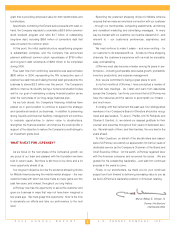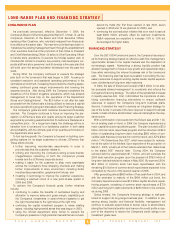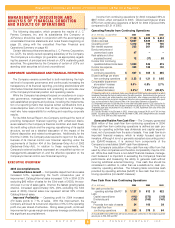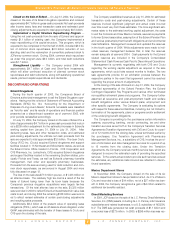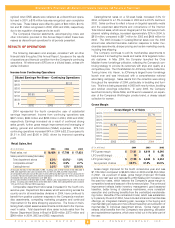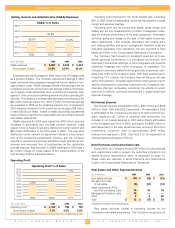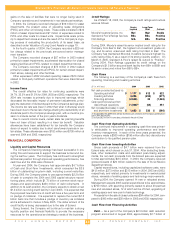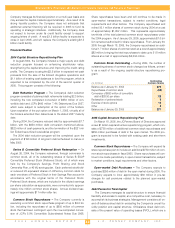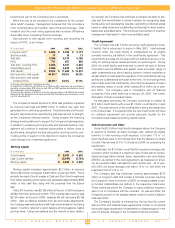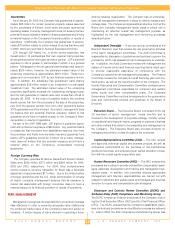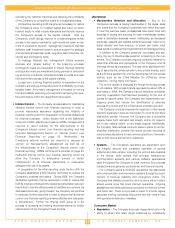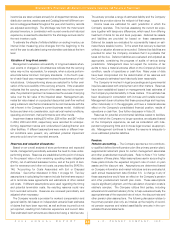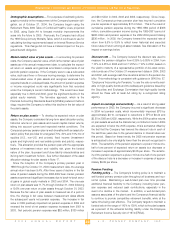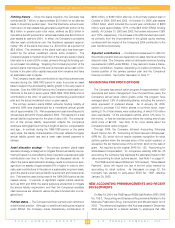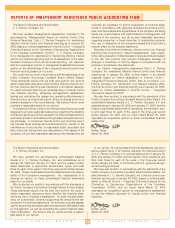JCPenney 2004 Annual Report Download - page 16
Download and view the complete annual report
Please find page 16 of the 2004 JCPenney annual report below. You can navigate through the pages in the report by either clicking on the pages listed below, or by using the keyword search tool below to find specific information within the annual report.
J.C. PENNEY COMPANY, INC.2 004 ANNUAL REPORT
Management’s Discussion and Analysis of Financial Condition and Results of Operations
14
Contractual Obligations and Commitments
Aggregated information about the Company’s contractual obligations and commitments as of January 29, 2005 is presented in the
following tables.
Contractual Obligations After
($ in millions)
Total 2005 2006 2007 2008 2009 5 years
Long-term debt, including current maturities
$ 3,923 $ 459 $ 21 $ 433 $ 203 $ –– $ 2,807
Short-term debt - Renner
22 22 — — — — —
Trade payables
1,200 1,200 — — — — —
Operating leases(1)
1,197 226 185 149 130 110 397
Contributions to non-qualified supplemental retirement
and postretirement medical plans(2)
504 75 76 78 81 32 162
Contractual obligations(3)
163 107 43 10 3 –– ––
Total
$ 7,009 $ 2,089 $ 325 $ 670 $ 417 $ 142 $ 3,366
(1) Represents future minimum lease payments for non-cancelable operating leases, including operating lease obligations assumed when the Company terminated third-party service contracts for certain store
distribution centers.
(2) Includes expected payments through 2014.
(3) Consists primarily of (a) minimum purchase requirements for exclusive merchandise; (b) royalty obligations; and (c) minimum obligations for energy services, software maintenance and network services.
The Company is predominantly engaged in the retailing business of buying and selling merchandise. In the normal course of business, the
Company issues purchase orders to vendors/suppliers for merchandise inventory to meet customer demand for style, seasonal and basic mer-
chandise. The Company’s purchase orders are not unconditional commitments but, rather, represent executory contracts requiring perform-
ance by vendors/suppliers, including delivering the merchandise prior to a specified cancellation date and meeting product specifications and
other requirements. Failure to meet agreed-upon terms and conditions may result in the cancellation of the order. Accordingly, the table above
excludes outstanding purchase orders for merchandise inventory that has not been shipped. Under the terms of the purchase orders, mer-
chandise is purchased on a F.O.B. (Free on Board) shipping point basis. As a result, the cost of merchandise shipped but not received by the
Company as of year end (in-transit merchandise) is recorded on the Consolidated Balance Sheets in Merchandise Inventory with a correspon-
ding offset to Trade Payables. As of January 29, 2005, the Company had approximately $364 million of domestic and foreign in-transit mer-
chandise, which together with trade payables for merchandise already received, is reflected in the table above. Additionally, the Company
issues letters of credit for merchandise inventory sourced overseas, which are included in the Commitments table below.
Commitments
After
($ in millions)
Total 2005 2006 2007 2008 2009 5 years
Standby and import letters of credit(1)
$ 153 $ 153 $—$—$—$—$—
Surety bonds(2)
80 80—————
Guarantees(3)
76 — 8 7 –– 3 58
Total
$ 309 $ 233 $ 8 $ 7 $ –– $ 3 $ 58
(1) Standby letters of credit ($143 million at January 29, 2005) are issued as collateral to a third-party administrator for self-insured workers’ compensation and general liability claims. The remaining $10 million are
outstanding import letters of credit.
(2) Surety bonds are primarily for previously incurred and expensed obligations related to workers’ compensation and general liability claims.
(3) Includes (a) $28 million for certain personal property leases assumed by the purchasers of Eckerd; (b) $18 million on loans related to a real estate investment trust; (c) $20 million related to a third-party reinsurance
guarantee; and (d) $10 million related to certain leases for stores that were sold in 2003, which is recorded in Accrued Expenses and Other.
FIFO EBITDA
($ in millions)
2004 2003 2002
Income from continuing
operations before
income taxes (GAAP)
$ 1,020 $ 546 $ 415
Add back/(deduct):
Net interest expense
233 261 226
Bond premiums and
unamortized costs
47 –– ––
Real estate and other
expense/(income)
12 (17) 59
Depreciation and
amortization
368 372 365
LIFO (credit)/charge
(18) (6) 6
FIFO EBITDA of continuing
operations (non-GAAP)
$ 1,662 $ 1,156 $ 1,071
Earnings before interest, taxes, depreciation and amortization
and LIFO (FIFO EBITDA) of continuing operations was $1,662 mil-
lion, $1,156 million and $1,071 million for 2004, 2003 and 2002,
respectively. The improvement over the past three years is due to
consistent execution of the Company’s turnaround strategies and
resulting higher income from continuing operations. FIFO EBITDA
is included in the leverage ratio covenant in the Company’s credit
agreement and is a key measure of cash flow generated and is
focused upon by debt investors and the credit rating agencies. It
is provided as an alternative assessment of operating perform-
ance. It is not intended to be a substitute for GAAP measurements
and may vary for other companies.


